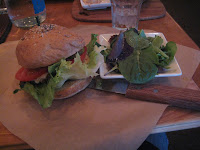
Vegetable melts can be served as a scrumptious appetizer, as a two-part meal with a soup, or as a vegetarian entree all by themselves. As you can see from the picture, when I made these for my family, I omitted the eggplant and olives, and used heirloom tomatoes rather than Roma tomatoes. I will include the directions if you would like to use the eggplant and olives, and the recipe is the same for whatever kind of tomatoes you use. Either way, these veggie melts will appeal to vegetarians and nonvegetarians alike.
1 eggplant (aubergine), about ¾ lb
salt
4 large, firm ripe Roma (or heirloom) tomatoes, about 1 lb
4 tbsp olive oil
1 cup thinly sliced sweet onion, such as Maui or Vidalia
5 oz spinach leaves, stems removed, about 4 cups loosely packed
1 tsp minced garlic, plus 1 clove halved
1 tbsp finely chopped pitted Kalamata olives
freshly ground pepper
4-6 slices sturdy whole grain bread
Basil leaves, thinly sliced
shredded mozzarella cheese
Peel the eggplant and cut crosswise into about ½ inch thick slices. Sprinkle both sides with salt and lay them in a colander set over a plate. Pay a second plate on tip to weigh them down and let stand for 1 hour. Rinse slices and pat dry with paper towels.
Preheat the oven to 425 degrees F. Halve the tomatoes lengthwise and remove the seeds. Arrange them, cut side up, in a baking pan and drizzle with olive oil. Arrange the eggplant on a baking sheet and brush both sides with olive oil. Place both pans in the oven. Roast the eggplant for 15 minutes, flip the slices, and then roast until lightly browned and soft, about 10 more minutes. Remove from the oven. Meanwhile, roast the tomatoes, flipping them and rotating the pan so they cook evenly, until the skins are shriveled and caramelized, 35-45 minutes. Remove from the oven, cover with aluminum foil, and let the tomatoes cool. Uncover and peel off any skins that have loosened. Reduce oven temperature to 350 degrees F.
Place a large frying pan over medium heat and heat the olive oil, then add the onions and toss to coat. Sprinkle with 2 tbsp water, cover, reduce the heat to low, and cook until the onion is wilted and tender, about 8 minutes. Then uncover the pan, stir in the minced garlic, and cook for 1 minute. Add the spinach leaves and toss to distribute evenly. Re-cover and cook until the spinach is wilted, about 5 minutes. Remove from the heat and add olives, and salt and pepper to taste. Stir to mix.
Rub 1 side of each bread slice with the cut side of a garlic half. Place the slices on a baking sheet, brush evenly with olive oil, and bake until toasted, about 12 minutes. Remove from the oven and preheat a broiler, or the oven to 500 if you don't have a broiler.
Make a layer of the spinach on each of the toasts, dividing it evenly. Top with 1 or 2 slices of eggplant, slightly overlapping them if need be. Then add 2 roasted tomato halves, sprinkle evenly with basil. Arrange a layer of cheese on top of each toast. Put the pan into the broiler or oven for 4 minutes or until the cheese is hot and bubbly.
Recipe from: Williams-Sonoma, Essentials of Healthful Cooking






























